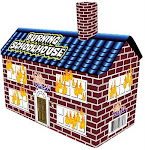I have not seen last night's Democratic debate yet, but during it, Bernie Sanders apparently said “When you’re white, you don’t know what it’s like to be living in a ghetto. You don’t know what it’s like to be poor.”
Er, no. How has Sanders lived for over seventy years without ever meeting any poor white people? Are there no poor white people in Vermont?
As funny is the reference to whites never experiencing the ghetto, considering that Sanders is Jewish, and “ghetto” originally meant the Jewish part of town. Aren't Jews white? Isn't Bernie Sanders white? Does he know nothing of his own history?
Speaking of which, there is widespread misunderstanding of the true nature of “ghettos” in general. The term, as Sanders' quote demonstrates, has a very unfavourable connotation. I think this is wrong.
The original “ghetto” was the Jewish neighbourhood in Venice. In fact, it was one of Venice's most prosperous neighbourhoods. Ghettos have recently gotten a bad rap because of the Nazis and the civil rights movement in the US South. The Nazis herded all the Jews into the old ghettos, which most of them had long left, as a prelude to shipping them off to be executed. These ghettos were as a result extremely overcrowded, and short of food and water. The Nazi ghettos were guarded, and Jews were not allowed to leave them under penalty of death.” These conditions have since been wrongly applied to ghettos in general, and there has been a general supposition that this was the case with ghettos before Nazi times. But before Hitler, the term “ghetto” had no clearly negative connotations. It was just the Jewish neighbourhood. Like TMR or Hampstead in Montreal. Forest Hill or Bathurst/Lawrence in Toronto. Nice places to live. Largely because by then it had developed the negative connotations, the term was transferred to the US during the civil rights movement in the US South to suggest there was something wrong with blacks living together in black neighbourhoods. After all, the main thrust of the movement was to promote integration over segregation, to disprove the claim that it was possible to be “separate but equal.” At the same time, the denigration of the traditional Jewish ghetto served the agenda of many who wanted to see anti-Semitism as endemic to European and Christian culture.
 |
| Jews being herded into the Krakow ghetto by the Nazis. |
Wikipedia writes, inter alia, “Jewish ghettos in Europe existed because Jews were viewed as alien due to their non-Christian beliefs in a Christian environment.[citation needed] As a result, Jews were placed under strict regulations throughout many European cities.[7].” Note that there is no citation for the first claim. The second reference is to a paper which in fact points out that ghettos involved no negative connotation until the Nazis.
There may have been laws is some places requiring Jews to live in the ghetto. Nevertheless, these laws had little or no effect. For the simple reason that Jewish ghettos would have existed more or less exactly as they did whether such laws existed or not.
To begin with, people of shared ethnicity, as a matter of course, want to live together. This is obvious to anyone who has seen a North American city populated by waves of immigrants. Toronto has its Little Italy, Little Portugal, Little India, Chinatown, Greektown, and on and on. Every big city between Montreal and Detroit even has a Corktown, where immigrants from this particular Irish city settled in the 1840s. It stands to reason. Live together, and your local school has heritage language classes for your kids; the local community centre has your traditional games and pastimes; your church or other house of worship is nearby; after work, you can spend time with others who speak your language and share your memories. Walk down the Danforth in the late afternoon and see all the old men playing backgammon in the coffee shops. Here in Saudi Arabia, foreigners almost always live in gated compounds, just like the Jewish ghettos. Do we feel deprived? No; we pay extra for the privilege.
 |
| Typical Saudi ghetto. |
 |
| Krakow ghetto gate |
Why would Jews or blacks or Hispanics feel any different? Indeed, TMR in Montreal chose to build a fence just a few decades ago.
In the old Jewish ghettos, Talmudic law even applied. They were largely self-governing entities. Kind of like some ethnic groups would die for today.
The streets were often relatively crowded, people lived within a small area, and they were surrounded by walls. You can see that the old ghetto in Barcelona, for example, is built to a different scale than other nearby areas. There is a reason for this. You may read this was because the wider civic authorities did not want Jews wandering abroad at night: They were forced to live together in the ghetto to prevent their roaming about at night,” explains the aforementioned Wikipedia reference. But this is not the real story. The real story is this: why would Jews want to be wandering abroad at night?
The issue is Jewish Sabbath observance. According to Talmudic law, an observant Jew could not leave his home during the Sabbath with anything, including money, in his pockets, and could not go anywhere he could not walk to on his own two feet. But an observant Jew had to go to the Synagogue for prayer on the evening of the Sabbath. This presented a technical difficulty, especially for the aged and infirm, unless Jews all lived quite close to the synagogue—in other words, in a tightly packed, enclosed community. Moreover, large groups of Jews walking after dark with nothing in their pockets, and with everybody knowing this fact, were very vulnerable. For their own safety, therefore, not for that of neighbouring Christians, Jews would naturally want to live in their own community safely separated from the rest of the city by walls. In addition, according to some legal interpretations, the wall made the entire ghetto “indoors,” greatly increasing the freedom of movement of those who lived within it.
So too, the black ghettos of the US were probably mostly voluntary at all times, and not necessarily a bad thing. “Until the 1970s, black ghettos were often seen by many African Americans as sites of thriving, bustling black business, stable black institutions, and neat, well-kept homes,” notes Wikipedia's reference. One notes the “Harlem Renaissance.” The close proximity of black cultural influences apparently produced a cultural flowering in this largest of black ghettos that has not been matched since. Arguably, the drive for desegregation since the Sixties, which has broken up many of the largest ghettos, has been a net loss for black culture. Which has not been in very good shape since.
Now don't get me started on “sweat shops.”












No comments:
Post a Comment